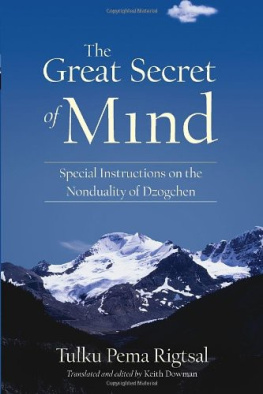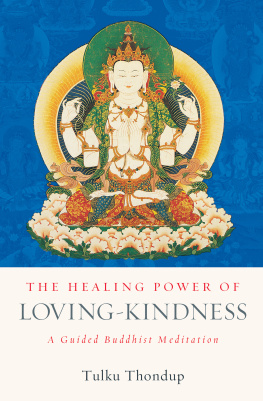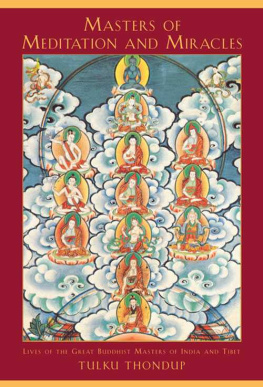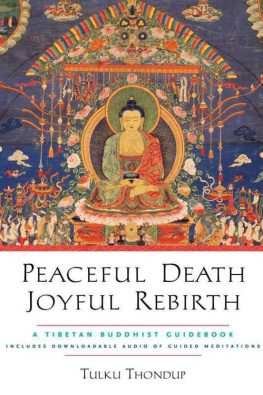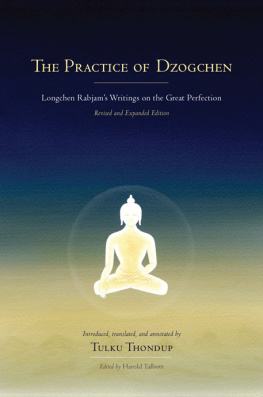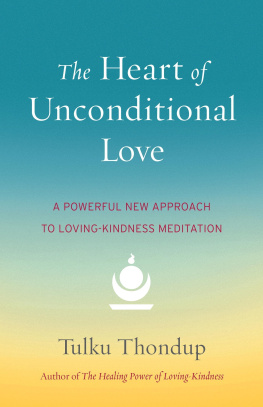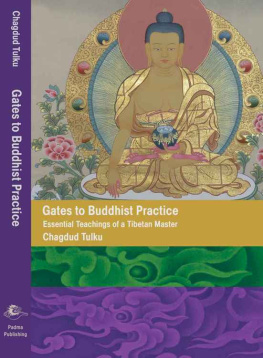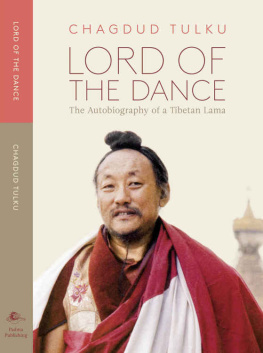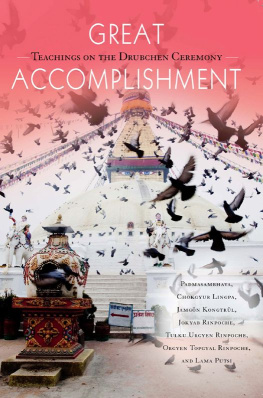ABOUT THE BOOK
This collection of fifteen articles and talks by Tulku Thondup constitutes a manual on how to transmute the situations encountered in daily life, whether external or internal, into spiritual disciplines and experiences. Among the topics covered are:
- The fundamental principles of Buddhism.
- The practice of meditation as a means of arousing compassion.
- How suffering can become a more powerful tool than happiness in achieving enlightenment.
- The symbolic significance of holy places, temples, statues, books, and other spiritual artifacts.
TULKU THONDUP was born in East Tibet and was recognized to be a tulku at age five. He studied at Tibets famed Dodrupchen Monastery, settling in India in 1958 and teaching for many years in its universities. He came to the United States in 1980 as a visiting scholar at Harvard University. For the past three decades he has lived in Cambridge, Massachusetts, where he writes, translates, and teaches under the auspices of the Buddhayana Foundation. His numerous books include The Healing Power of Mind, which has now been published in eighteen languages, and Boundless Healing, which has been published in eleven languages.
Sign up to receive news and special offers from Shambhala Publications.

Or visit us online to sign up at shambhala.com/eshambhala.
ENLIGHTENED JOURNEY
Buddhist Practice as Daily Life
TULKU THONDUP
Edited by Harold Talbott

SHAMBHALA
Boulder
2016
Shambhala Publications, Inc.
4720 Walnut Street
Boulder, Colorado 80301
www.shambhala.com
1995 by Tulku Thondup Rinpoche
Buddhayana Series: V
All rights reserved. No part of this book may be reproduced in any form or by any means, electronic or mechanical, including photocopying, recording, or by any information storage and retrieval system, without permission in writing from the publisher.
Library of Congress Cataloging-in-Publication Data
Thondup, Tulku.
Enlightened journey: Buddhist practice as daily life / Tulku Thondup; edited by Harold Talbott.
1st ed. p. cm.
Includes bibliographical references and index.
eISBN 978-0-8348-0285-8
ISBN 1-57062-021-0
1. Spiritual lifeRi-ma-pa (Sect) 2. Rdzogs-chen (Ri-ma-pa) I. Talbott, Harold. II. Title
BQ 7662.6. T 56 1994 94-36154
294.3444dc20 CIP
This book contains diacritics and special characters. If you encounter difficulty displaying these characters, please set your e-reader device to publisher defaults (if available) or to an alternate font.
T HE MOST ESSENTIAL TRAINING in Buddhism, and for that matter in any spiritual path, is the skillful means that enables the trainees to transmute every aspect of their daily life into spiritual training. Spiritual training is the exercises that release the intensity of our mental grasping and the driving force of our craving. Spiritual training eases the pain and suffering created by our narrow, rigid views and our burning, confusing emotions.
Spiritual training is crucial to the realization and experience of openness, peace, joy, love, and wisdom. If our mind is filled with peace, love, and wisdom, our mental and spiritual energies will be strengthened. If our mental and spiritual energies are strengthened, the physical elements of our body become healthy and the events in our life become positive. By the same token, if our mental energy is strong, our body will be healthy and our life positive; our mind will be naturally more peaceful and joyful. The days of our entire life will flow in a cycle of true happiness. As the third Dodrupchen Rinpoche writes:
When your mind is not disturbed, your energy will not be disturbed, and thereby other elements of the body will also not be disturbed. Because of this, your mind will not be disturbed, and so the wheel of joy will keep revolving.
There are two important ways to transmute daily life into training. First, if you have realized the wisdom that transcends mental conceptions, or even if you have not yet transcended mental conceptions but have powerful spiritual experiences such as compassion, devotion, or contemplation, then you can unite or transform all appearances and experiences into a support for the energy of realized wisdom and spiritual experience.
For great adepts, every phenomenal appearance becomes the expression of their inner wisdom itself. All appearances become the power of realization, like the rays of the sun that coax the flowers of happiness to blossom in the hearts of all those around.
Second, for ordinary people like ourselves, whose minds are conceptual, emotional, and unrealized, it is essential to rely on any skillful meanspositive and spiritual images, signs, sounds, or sources of poweras the means of generating spiritual energy. If we could see the objects that surround us as a source of inspiration and peace, they will generate peace and joy within us because of the power of our own mental perceptions.
In the same vein, we cannot transform negative situations into positive ones if we see them as negative and react to them with negative emotions. As long as we hold on to negative perceptions, viewing our circumstances through dark shades, the whole world will appear negative, and all our efforts will be one never-ending struggle. So we should lay the foundation of true peace and joy in our own minds by developing
Foes are as unlimited as (the extent of) space;
They cannot possibly all be overcome.
Yet if you just overcome the thought of hatred,
That will be equal to overcoming all foes.
Where is the leather
With which one can cover the earth?
But wearing a leather sandal
Is equal to covering the earth with leather.
This book contains fifteen of my published articles and transcriptions of talks. It is divided into two parts: an introduction to the Buddhist path and a discussion of meditation practice. The core of this book is the article on the meditation practice of Ngndro, the essential training of the Longchen Nyingthig tradition of Tibetan Buddhism. The Ngndro embodies a complete process of training, beginning with inspiring ones mind toward Dharma and ending with unifying ones mind with the enlightened mind of the Buddha, universal enlightenment. The other articles deal with introductory or supportive material which, taken together, constitute a manual on how to turn the various experiences we encounter, whether external or internal phenomena, into spiritual views, disciplines, and experiences.
Part One consists of six articles. They form an introduction to the spiritual view, culture, and life, which are an important means of transmuting our physical and mental life into Dharma training.
1. Using Daily Life as the Practice of Dharma. This article summarizes some of the fundamental principles of Buddhismwho we are and why we can turn our daily life into spiritual training and realize Buddhahood, the state of ultimate peace and wisdom.
If we follow the right path of spiritual training, we can overcome all of lifes miseries, which are mere illusions of the deluded mind, and be like dreamers waking up from a nightmare. The fully enlightened nature could be spontaneously awakened in us, as we are all Buddha in our true nature. Suffering is the by-product of our mental concept of grasping at self, fueled by emotions of aggression, greed, and confusion. Training in various meditations such as patience and the beneficial attitude for others pacifies our negative emotions and concepts, and simultaneously generates in us peace, joy, and wisdom.
Next page

